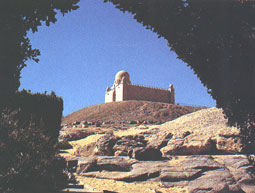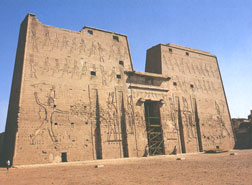Aswan, Egypt's sunniest southern city and ancient frontier town, has
a distinctively African atmosphere. Small enough to walk' around and
graced with the most beautiful setting on the Nile, the pace of life
is slow and relaxing. Days can be spent strolling up and down the
broad Corniche watching the sailboats etch the sky with their tall
masts or sitting in floating restaurants listening to Nubian music
and eating freshly-caught fish.
Here the Nile is at its most beautiful, flowing through amber desert
and granite rocks, round emerald islands covered in palm groves and
tropical plants. Explore the souk, full of the scent and color of
spices, perfumes, scarves and baskets; view the spectacular sunsets
while having tea on the terrace of the Old Cataract Hotel. Aswan has
been a favorite winter resort since the beginning of the nineteenth
century and it's still a perfect place to get away from it all.
Elephantine Island: One
of the strongest forts along Egypt's southern borders, this island
lies opposite to the "Cataract Hotel". Its chief deity was "Khnum",
in the shape of a ram's head. The tourist is advised to first tour
the island before visiting its monuments and museum.
The Island Temples: There
are ruins of several stone temples from various periods. The
inscriptions on the pylon of a hall in the southern temple depict
Alexander II as king of Egypt while offering sacrifices to the local
deities.
The Museum: Located
east of the old city, the museum houses a number of important relics
from Graeco-Roman times, collected from Aswan and Nubia.
The Nilometre: Dating
to the Roman period, the Nilometre shows the height of the Nile
floods in Greek, Demotic and Arabic, and was used until very
recently.
The Gilika Island: This
island now houses the Temple and relics of Philae island that was
submerged by the waters of the High Dam. The Temple of Philae was
dismantled and re-assembled on this island which lies about 500
meters from the original Philae Island. Sound and Light Spectacle is
performed in various languages.
 The
Agha Khan Mausoleum: The
Mausoleum of the late leader of the Ismaili sect stands on the west
bank opposite them Cataract Hotel. It is an exquisite example of
Fatimid architecture.
The
Agha Khan Mausoleum: The
Mausoleum of the late leader of the Ismaili sect stands on the west
bank opposite them Cataract Hotel. It is an exquisite example of
Fatimid architecture.
Plantation Island : Lies mid-stream, near Elephantine Island, is a
natural exhibition of equatorial and tropical trees and shrubs.
Amun Island : A small island on which a tourist hotel was built.
Tombs of the Nobles: These
rock-tombs are hewn in the western hills, opposite the northern tip
of Aswan, and date back to the 23rd century B.C. The inscriptions
covering The walls of these tombs depict the role of these nobles in
protecting the land, and of their journeys to the interior of
Africa. The Monastery of St Simeon (Deir Amba Sama'an): Dating back
to the 6th century AD, the Monastery is one of the most intact
Coptic monasteries, It comprises a church with paintings showing
Christ and the Saints.
The Unfinished Obelisk: This
huge unfinished obelisk measures 41 meters in length and 4 meters
square at the base. It is important because it shows the techniques
adopted by the Ancient Egyptians in cutting out these obelisks.
Amun Village: On
the west bank, and overlooking Lake Nasser, the 48-acre village
comprises a tourist hotel, with a main restaurant and an Italian
restaurant, a fully-equipped therapeutic center, and 352 bungalows
(chalets) built on Nubian architectural lines.
From Nubia Temples:
The Temple of Kalabsha: Dating
back to the Roman Emperor Octavius Augustus (30 BC-14 AD), the
temple was moved from its original site 55 kms south of Aswan, on
the west bank, and rebuilt near the High Dam. It is one of the
largest sandstone temples in Nubia. Its walls are covered with texts
and inscriptions depicting Egyptian deities such as Isis, Osiris and
others.
Beit el-Waly Temple: This
rock-hewn temple is one of the five temples built by Ramses II in
Nubia. It comprises a courtyard, a hypostyle hail, and a kiosk, with
multicoloured texts and inscriptions, as well as scenes of the King
in the battlefield.
Features of modern
Aswan:
The Aswan Dam: Built
in 1902 AD south of Aswan, it signaled the beginning of modern
irrigation in Egypt.
The High Dam: This
20th century engineering miracle is one of the largest dams in the
world, and was built to safeguard Egypt against the high Nile floods
which either destroyed large tracts of land or ran wastefully into
the Mediterranean. The dam, 111 meters above sea-level, is 3,600
meters long and 40 meters wide at the top.
There are several
other monuments in the Governorate of Aswan:
The Temple of Kom-Ombo: Located
in the town of Kom-Ombo, 45 kms north of Aswan, the Temple, dating
to the Ptolemies, is built on a high dune overlooking the Nile.
There are also tombs from the Old Kingdom in the vicinity of
Kom-Ombo village.

The Temple of Edfu
The Temple of Edfu: This
huge and exquisite Temple, from the Ptolemic period, and devoted to
the god, Horus, is located at the town of Edfu, 123 kms north of
Aswan.